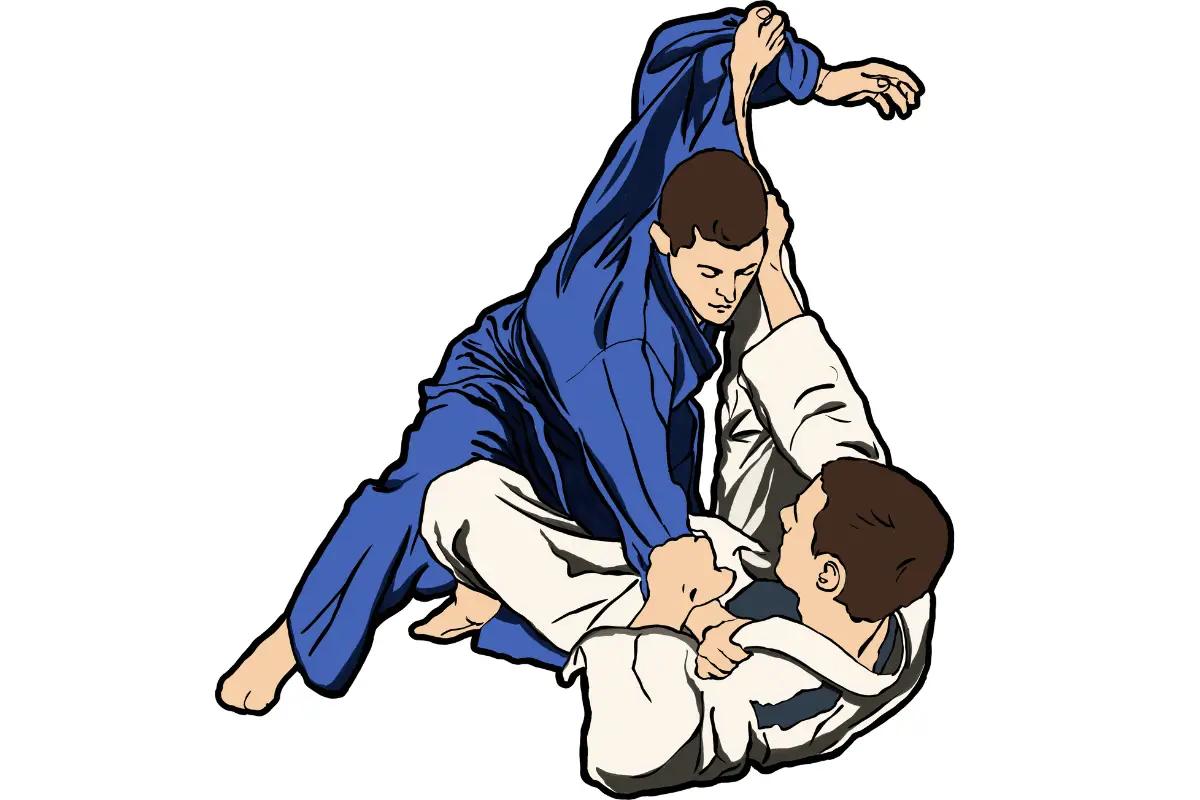The blue belt is only BJJ’s 2nd belt. Many grapplers can advance from the white to the blue belt, but it doesn’t come easy. You have to work extremely hard over a long period to advance to the following belt color. So, why is it that they’re so dangerous?
BJJ blue belts are dangerous because their motivation and confidence are at their peak. That’s why you see them win against more advanced grapplers, such as purple, brown, and even black belt; it’s more common than you think. Once you attain the blue belt, you’re definitely a competent grappler.
Imagine how good you would feel if you were to advance to the next rank. You would feel confident, motivated, and willing to excel at everything you do.
That’s why they can be dangerous, especially if they take training seriously. Many grapplers view BJJ as a hobby, and that’s it. However, it’s much more than that for others.
They treat it as their lifestyle. It all essentially begins and ends with Brazilian Jiu-Jitsu. This article will provide information on what and why blue belts in BJJ are so dangerous. Likewise, we’ll review various tips to achieve it faster and answer some common questions along the way.
Alright, without further ado, let’s dive in.
Why BJJ blue belts are dangerous
Most of us wouldn’t think the 2nd ranked belt in a martial art can be as dangerous. However, that is, in fact, the case. This section will examine why that’s the case and what makes them that way. So, let’s go over the primary reason blue belts are dangerous.
Brazilian Jiu-Jitsu blue belts are dangerous because their confidence and willingness to excel are at their peak. However, they’ve just progressed to the next rank and are still novice enough to have more motivation to advance to the next belt color, the purple belt.
It’s quite interesting to see blue belts win spars and competitions against black belts. You won’t see it anywhere else, especially if the practitioner takes his training seriously.
Many grapplers treat BJJ as a hobby. And, while that’s legitimate, as it provides countless mental and physical benefits, it’s a lifestyle for others.
Their entire day revolves around Brazilian Jiu-Jitsu and ways they can boost their progression. So, they’ll inevitably be more competent grapplers, even if they’re just blue belts.
What makes BJJ blue belts dangerous?
This section will review the 5 reasons that BJJ blue belts are competent fighters. However, if you wish to understand what you need to implement in your life to start progressing faster and becoming more capable, here’s the answer for you.
#1 – Hunger to excel
A hunger to excel is what makes us, human beings, progress faster than our peers. We want to utilize this fact and implement it into our routine. It’ll be best if you aim as high as possible, so you can also achieve greater feats.
Blue belts will do anything to be the best fighters, at least some of them who treat BJJ more seriously. This martial art isn’t a hobby; they want to become the best fighters.

So, they’ll eventually become greater fighters faster.
#2 – Peak motivation
How would you feel if you were to progress to the next rank in something important to you? Let me guess; you would feel satisfied with yourself. But, likewise, you would want to achieve more and do it faster, as your motivation would be at its peak.
That’s precisely the case here. Blue belts have just progressed to the next rank, and they feel more confident, with higher self-esteem, and will not have a problem doing more work.
That’s the 2nd reason for their exception competency.
#3 – They already know the basics
How capable can you be if you’re a white belt? It doesn’t matter how big you are or how hungry you are to excel. The truth is that you won’t be able to be as competent in the first 2 years of your training.
And 2 years will pass (I’ll point out the exact time later in the article) until you get the blue belt. So, consequently, you already know the basics when you get to wear the blue color on your Gi.
Now, you’re more advanced and can use what you learned to beat more advanced grapplers, such as brown and black belts. Unfortunately, many black belts treat BJJ as a hobby. And again, this is more than legitimate. But you could swipe them if you treat BJJ more seriously.
#4 – High confidence
The following reason blue-colored belt grapplers are capable is their confidence. And again, this relates to all the aforementioned reasons.
You’re ready to take on the world when you pass the first major obstacle, the white belt. Of course, you have much more to learn—but are at your peak motivation. So you want to attend training and start getting more and more results.
And as a result, your confidence is high. Now, confidence is the key to a lot in life. So your performance in all areas of life will get a boost if your confidence is up there. Thus, you perform better if you’re a blue belt.

You should focus on increasing your confidence right now, even if you’re not a blue belt in BJJ. You want to continuously work on yourself, as that is one of the primary benefits of training in martial arts.
And if you want to learn more about the benefits of martial arts, follow this link.
#5 – They’re more than competent
So, they’ve learned the basics. They know how to pass the opponent’s guard, escape submissions, and perform numerous offensive techniques, such as the Kimura, Americana, and Guillotine choke.
Now all that’s left is to combine everything. You learn the basics when you’re a white belt. On the other hand, you know to combine the basics when you’re a blue belt. Therefore, some will claim it’s impossible to beat an advanced grappler when you’re a white belt; frankly, I agree.
Once you know to combine the basics, you’re more than competent. All that’s left is to have a growth mindset and start training hard, which blue belts have no problem with.
Tips on getting the blue belt in BJJ
Advancing through the belts in any martial art is more than problematic. You have to invest much of your time and mental energy while expecting nothing in return. However, the benefits and results do eventually come.
As you know already, I’m a big fan of learning. Naturally, therefore, you shouldn’t stop learning, even if you believe you’ve mastered the art of Brazilian Jiu-Jitsu.
So, I’ve decided to include this section in this article. This section will be for the practitioners who want to advance through the belts swiftly. And we’ll dive specifically into the common challenges that blue belts in BJJ face and how they can deal with them.
Tip #1 – Set small milestones
Setting small milestones is the first tip to getting to the blue belt in BJJ faster. Your end goal is probably not to attain the blue-colored belt. It’s likely something much more significant, such as getting a black belt or improving yourself.
However, the power of setting small milestones is astounding. So you want to keep on setting goals that you can see yourself getting very shortly.
Let’s say your goal is to attain the black belt. Your small milestone can be (if you’re a white belt) to attain the blue belt. But, of course, it can be much smaller than that: such as perfecting your Kimura or holding on for 4 minutes against a brown belt.
These achieve goals will make you more motivated in almost an instant. Try this practice by setting 2 small milestones you want to achieve.
Tip #2 – Prioritize learning
The greatest BJJ coaches and masters have more to learn, and they admit it. So, how can you say you have nothing else to learn? People invest their lifetimes into Brazilian Jiu-Jitsu and continuously learn and advance. That’s why they never stop progressing.
If you’re a blue belt, you want to prioritize learning because you have so much more to learn. It’ll be best to listen to people with more experience than you, who you think are competent grapplers. You even want to consider listening to the advice novice BJJ practitioners give you; that’s how humble and willing to learn you should be.
This will help you progress much more quickly. In addition, you’ll be able to achieve fantastic results when you do that, as you’ll always have something else to focus on.
Tip #3 – Don’t get complacent
The last tip is specifically regarding blue belts and human nature. We, human beings, get complacent when we progress toward our goals.
We think: “Well, I’ve sparred for 2 hours. I can do take a break and eat junk food while being on my phone for 2 hours.”
Unfortunately, that is not how we can maximize our potential. Getting complacent is in our nature. We don’t want to work hard 24/7, which makes total sense. However, we shouldn’t diminish our progress if we make progress.
That won’t lead us anywhere.
So, please don’t get complacent and keep working hard, particularly when you don’t feel like it.
Is getting the blue belt in BJJ hard?
Advancing through BJJ belt colors will take more time than you think. However, some won’t require you to be at a certain skill level. For instance, you’ll have to undergo a series of tests to get the black belt and, thus, bring to a certain skill level to advance.
As a general rule, getting the blue belt in BJJ will require you to invest plenty of time in training, but it’s not as much about your current skill level. You won’t have to do any test, for the most part, to attain in. Advancing to specific belts will require you to undergo a series of tests, such as the black belt.
So, to answer the question shortly, it’s not as difficult to attain a blue belt in BJJ.
How long will it take to achieve the blue belt in BJJ?
Achieving a blue belt in BJJ may take anywhere from 6 months to 2 years. As a result, most trainees will quit before reaching such a rank. Additionally, BJJ’s belt system has 4-stripes for each belt color. Once earning all 4-stripes, you can advance to the next belt tier.
If you want to read what long it really takes to achieve BJJ’s blue belt, follow this link.
Do BJJ blue belts end up being black belts?
Unfortunately, most BJJ blue belts won’t end up being black belts, as many grapplers quit after advancing through the white belt. However, others who keep themselves consistent and dedicated in training—will eventually reach the black belt.
It’s all a matter of consistency and dedication.
What is the blue belt syndrome (curse)?
The blue belt curse in Brazilian Jiu-Jitsu is a repeating pattern that grapplers who currently are blue belts will quit before advancing to the next belt color, purple. This usually happens because these trainees overcome the first primary obstacle, which was their initial goal. So, they’re left without a goal (unmotivated.)
How long do people stay blue belts in BJJ?
The blue belt is where, more often than not, the BJJ trainee learns most of the techniques one will ever learn. A minimum of 2 years in the blue belt is required before progressing to the following color. That’s when most trainees quit, as the process is longer than most expect.
If you want to learn more about BJJ’s belt ranking order, follow this link.
Final words
This article was all about the blue belt. However, if you’re currently in this rank, know that this article applies to all grapplers. You can, if you want, overcome the obstacles I presented in this article by being more dedicated and setting more goals in the long term.
Likewise, you can follow the tips I presented in this article to see more results sooner. Eventually, this will be the difference between the low and high-level grapplers.
So, defy the odds and start progressing faster.
Here are other articles you’d enjoy reading:
You’re a BJJ Black Belt – Now What?
The Mighty BJJ Coral Belt – A Comprehensive Guide
BJJ Grandmaster – Who Are the Mysterious Red Belts?
The BJJ Purple Belt Paradox – Are They Even Good?

